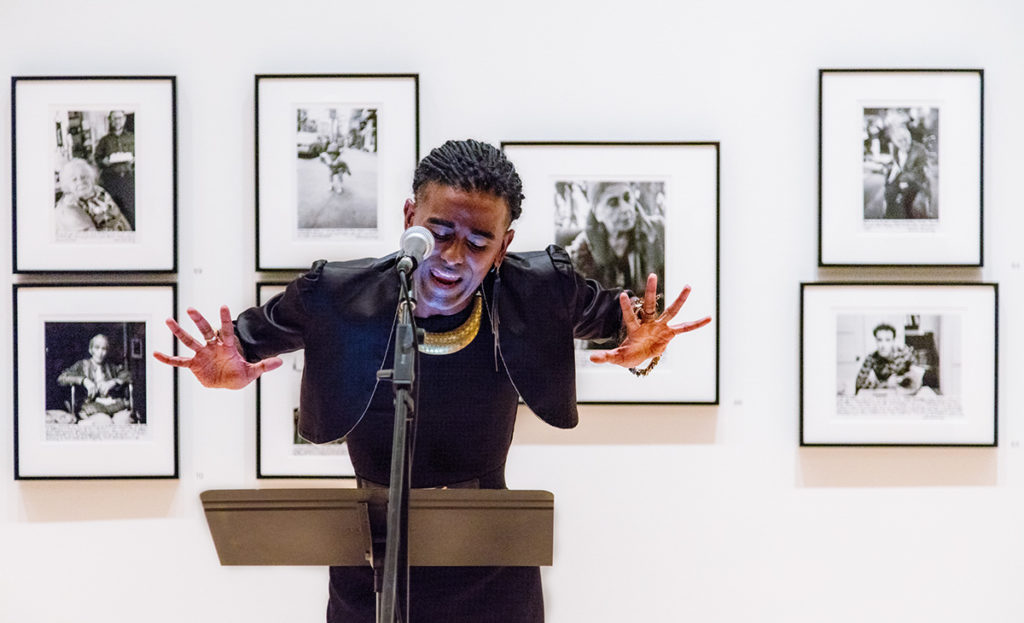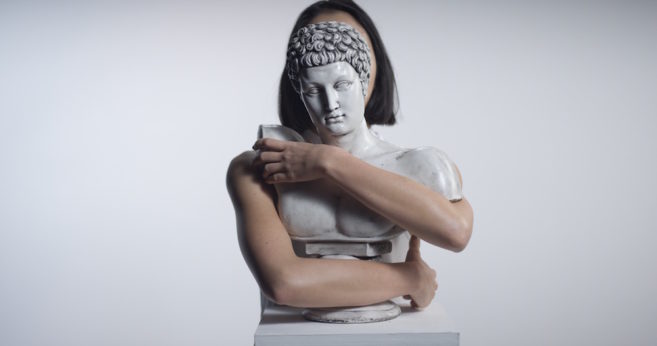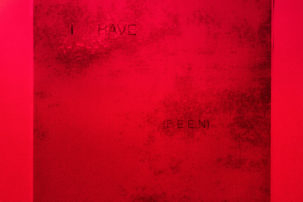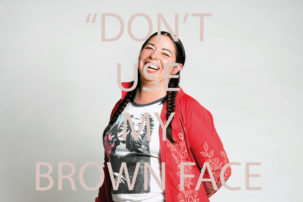“Queer” and “curating”: these are two broad, rather opaque terms that have gained popularity as objects of study in the realm of visual art. Rarely, however, are these terms read alongside one another as “queer curating.” For some time, as a writer and curator, I have grappled with this idea. Is it possible to identify a mode of curatorial practice that possesses a specifically queer orientation?
The nine contributors brought together in this discussion—Lacie Burning, Jon Davies, SD Holman, Kama La Mackerel, Allyson Mitchell and Deirdre Logue (FAG: Feminist Art Gallery), Jordan Tannahill and William Ellis (Videofag) and Syrus Marcus Ware—trace lines of thought that reject assimilationist art historical narratives and essentialist interpretations of identity, community, and shared history. Here, the “queer” in queer curating is not simply framed as a stable sexual identity category, but rather signifies a pursuit of difference itself.
Outside the space of this text, these nine contributors maintain creative practices that challenge social norms and customs in very different ways. Nevertheless, throughout the discussion, they are linked together by a common interest in forms of ethical-political engagement that are both radically inclusive and unashamedly disobedient.
How would you begin to describe the various tactics, principles and processes that are central to practices queer curating?
Jordan Tannahill and William Ellis: I suppose “queer curating” is about queering curation; about levelling the traditional hierarchies that have embedded themselves in art-world relationships, finding new collaborative models, and seeking to support, listen and learn from artists who find themselves on the margins.
Jon Davies: I am interested in the complex, affective and unanticipatable relationships between an artwork and an observer, how artworks can pique messy or indescribable emotions, like feeling implicated or in love. I hope to complicate distinctions between artists’ lives and their work, and think about the continuities between social, sexual and psychic life and one’s aesthetics and use of form. I continue to cling to the word “queer” for the sense of ambiguity I think it can still represent, particularly at a time of hard binaries and misplaced certainties—I guess I see it as an ethos.
Allyson Mitchell and Deirdre Logue: We feel it is important to productively question the authority, economy and adoration of the notion of the curator—lots of people want to be one—we do not. Instead, we concentrate our queer feminist energies on enabling and nurturing queer and feminist art and ideas and on creating an art system that is:
Open to change, flexible, soft;
Aligned with practices in social justice, politically alive, on the ready;
Ego-boosting initiatives that centre the experience of the artist and values the artist as a worker like any other;
Low-fi, DIY, on the ground, of the earth;
Accessible, holistic, feeling, loving;
Actively decolonizing, willing to do a complete rewrite;
And always intersectional.
Syrus Marcus Ware: I would first begin by clarifying what we mean by queer. Borrowing perhaps from E. Patrick Johnson’s concept of “quare studies,” wherein Black queer and trans identity is unique and distinct from homonormative understandings of contemporary queerness, I would love to talk about “quare curating.” Black queers have been making a mark by creating complex exhibitions rooted in intersectionality, offering political challenges and forums for discussion, and offering a contrast to the pervasive white supremacy and anti-blackness in the art world that has virtually shut out Black Canadian artists from having their work shown, critically engaged with, and collected. Quare curating offers exciting opportunities to create and share work rooted in politics, justice and social change making.
Kama La Mackerel: I have always thought of queer curating, queer art and queer cultural production as practices that cannot be reduced to a single definition or form. I see the practices of queer curating, first and foremost, as located in identity politics: “Queer curating” as an umbrella term that represents multiplicities of bodies and identities that inhabit the LGBTQ+ spectrum.
I think what sets queer curating aside is that it has always been a grassroots, underground, DIY practice that gravitates around “queer community” (which is also a slippery term to critically reflect on).
It is also important to think of processes of queer curating through an intersectional lens. I do not believe that there is a process of queer curating that is just queer: queer curation can and should be queer and Indigenous, queer and Black, queer and diasporic, queer and disabled, etc.
Lacie Burning: One of my primary concerns is to take an intersectional approach. People who are disabled, trans, transfemme, non-binary, Black, visibly racialized or sex workers are not given much opportunity and are often intentionally excluded. As a previous article in Canadian Art pointed out, this is quite clearly the case.
SD Holman: I’m going to answer this with a quote I use as a touchstone when making my own art and when curating, by Trinh Minh-ha from Woman, Native, Other: Writing Postcoloniality and Feminism (1989):
“How do you inscribe difference without bursting into a series of euphoric narcissistic accounts of yourself and your own kind? Without indulging in a marketable romanticism or a naïve whining about your condition? . . . How do you forget without annihilating? Between the twin chasms of navel gazing and navel erasing, the ground is narrow and slippery, and none of us can pride ourselves on being sure-footed there.”
I find it useful to think through this subject by considering two interrelated, yet distinct curatorial approaches. One employs the term queer in a qualitative adjectival sense to describe an active process of disordering, while the other treats it as a determinable thing, substance, and identity. How do you, if at all, make a distinction between queer methods and queer content?
Jordan Tannahill and William Ellis: Sexuality and gender are so specific to each and every person. At Videofag, we did not want to force our own preconceived ideas on queerness onto anyone. Even a cis-gendered husband and wife couple working in a gallery setting called “Videofag” was interesting to us and we were open to the dialogue that would come from that. Allowing people to explore queerness in their own way is important. This, of course, does not mean that there was no focus on exhibiting artists that identify as LGBTQ, which is necessary especially in the context of queer history, gay rights and issues that the LGBTQ community continues to face. There has to be a balance between both methodological approaches—both are necessary.
Jon Davies: I hope that “queer” will always retain its associations with non-normative genders and sexualities, but it’s most important for me as a kind of doubled vision, a way of looking askance at the world—having a heightened, critical sensitivity to the fictions we live under and that shape us. (Mine is based on a deeply felt sense of existential irony that derives from camp.) Whether artists (or curators) use the word “queer” or not, I feel a kinship with those holding onto a sense of difference and apartness that evolves over time, people who consciously align themselves with past and present struggles and queer touchstones.
Kama La Mackerel: I do believe that there is queer content, but I do not believe there is a method that is inherently queer. Granted, in the first decade of the 2000s in particular, there was an ongoing effort of questioning established methods, of disrupting them to develop a queer methodology, a queer aesthetics, a queer way of writing—queer theory established itself as a legitimate field of study. This queer method, however, has lost its relevance to me over the past few years. As queer curation has become increasingly institutionalized, it also lost its political imperative. It became a question of aesthetic practice that was disruptive only insofar as it remained rooted within respectability politics, only insofar as it remained within boundaries that were not too threatening to a dominant white and cisgender aesthetics.
Lacie Burning: The two terms do not need to be mutually exclusive. When I was co-curating “Unsettling Colonial Gender Boundaries” with June Scudeler and we were looking for artists to approach to commission new work, we considered this question closely. We ended up commissioning works by Thirza Cuthand and Chandra Melting Tallow. While the two works differ in terms of representational content and research methods, the core concerns remained the same.
SD Holman: I’m less interested in the inclusion of queers in the art museum and the art canon, because we are of course already there. Yet queer artists are not often recognized as such; we are included but not represented. We are welcome in the art world as long as we don’t flaunt it.
With regards to the distinction between queer methods and queer content, I am interested (read: horrified) in the ways that the mainstream world, despite the appearance of greater societal acceptance for queers, continues to scrub queer content from the work and lives of these artists. The critic Darren Jones recently pointed out how the two galleries representing Felix Gonzalez-Torres have omitted any mention of AIDS, HIV, or his partner Ross in major New York solo shows. This kind of erasure is rampant in the homogenizing commodification of art, especially after the artist has died.
What do you make of the idea of an ethics of curating? How can “queer” be used to enter other cultural discussions that go beyond the issue LGBT+ visibility?
Jordan Tannahill and William Ellis: By disordering dominant modes of thinking and action, queerness naturally lends itself to activism. A lot of the work we curated had little to do with “LGBTQ visibility” as such, but deployed queerness as a means of examining gentrification, colonization, patriarchy, immigration policy, intersectional identity, sex work, systemic racism and so on.
Jon Davies: I hope that “queer curating” entails a sensitivity to the more subtle and covert ways that power operates in the art world and beyond. I also think that we have learned that visibility isn’t a holy grail, being visible in culture makes some of us feel “real” but leaves others of us in the dark. I think refusal and opacity are worth exploring because working from the shadows instead of being watched can be powerful. I think it’s important to work under the weight of a lost generation who died of AIDS while not losing sight of everyone still being killed in myriad ways now.
Allyson Mitchell and Deirdre Logue: FAG is a way of undoing things, a mode of operation that is different than those that are practiced by art institutions (even if they sometimes overlap). It is experimental, nimble and adaptable to the immediate needs of our communities so they can do what they need to do.
As a way of queering/queerness, we are supporting an art community and holding space for other voices, projects and collaborations. For example, when their previous gallery was lost in 2016, we gave away our space to the self-described nomadic gallery Younger Than Beyonce. This led to us working on a collaborative moving exhibition with the Public Studio and Margins of Eras Gallery for March and April 2018 as a direct, concrete way of supporting and tending towards each other.
Kama La Mackerel: I think of curatorial practices as inherently political, just as much as I think of the political sphere as inherently aesthetic: both these fields are concerned with ordering, with what can be visible or not, with what can be said or not. Both political and aesthetic practices are concerned with rendering different bodies and subjectivities visible, or invisible. I hence think of an ethics of curating as an imperative. When it comes to queer curatorial practices specifically, I think that this imperative should be grounded in intersectionality.
Queerness can be read as a force of difference, one that defies the authority of powerful cultural institutions and the patrons they serve. With this in mind, perhaps we can discuss the different spaces where queer practices thrive in contemporary Canadian society.
Jon Davies: I am not sure how disruptive “queer” is when the art world as a power structure is so good at swallowing up every challenge to its conventions and authority. Why does the contemporary art world have to assimilate and own the histories of experimental film, for example, or dance or grassroots protest as if everything is better off in a white cube than somewhere else? Basically I think that it is difficult for something not to be lost in bringing queer work into institutional contexts, just because so much of its power has been drawn from subcultural and experimental social worlds.
Allyson Mitchell and Deirdre Logue: Yes, maybe the next issue of Canadian Art can focus on that.
Syrus Marcus Ware: The queer practices of disruption, interventionist force, and challenges to authority are also practices of Black radicals and are alive and well within, yes, curatorial projects as we have been discussing. But they are obviously also alive and well in the daily direct actions of Black queer organizers on the front lines of a Black Lives Matter highway shutdown, in the creative outputs of the activists who have shut down the INAC office in Toronto for the past few months, and in the tireless fight of queer and trans disability justice activists fighting for grave markers at the former Huronia Regional Centre, to name but a few examples.
Kama La Mackerel: I think these spaces still exist across Canada through local, community-based, community-curated, grassroots festivals, shows, exhibits, and other art initiatives. These spaces are also often supported by artist-run centres and/or artist collectives whose mandate is to support marginalized artists and marginalized voices. To which extent these practices actively engage with and challenge the authority and power of cultural institutions is up for discussion, but at the very least, they create alternative spaces for emerging and/or less recognized queer practices.
Lacie Burning: This is a difficult question which deserves three answers. The examples function separately but each undermine powerful cultural institutions.
Kent Monkman’s touring and self curated exhibition “Shame and Prejudice: A Story of Resilience” has been positively received. This reception could be indicative of many things and should be explored more in depth.
There has been a recent influx of queer representation in the mainstream media. I cannot say for sure whether it thrives in these spaces because this sort of “minority” representation comes with its own set of problematics.
There are many online enclaves dedicated to identities within the LGBTQ2SIA+ spectrum. As a young trans/non-binary person I found refuge in the online community of trans people sharing their stories, experiences, and resources. They function to undermine cis-heteronormativity at home and keep young queer and trans people safe.
SD Holman: For generations, we have carved our own spaces out of a hostile world, spaces where we can sing and dance and paint and rhyme and fuck our resistance, spaces that meld struggle with celebration, politics with sex, serious purpose with more fabulous than anyone could ever swallow. The Queer Arts Festival (QAF) was specifically created as one of these spaces, an opportunity for queer artists to do the things that are hard to do as queers in the art world, as well as those things that are hard to do as artists in the queer world, including—perhaps especially—at the intersections that get stonewalled in both of these worlds.
Queer spaces are often temporary and contingent, rainbow-glossed bubbles blooming briefly before they give way to exhaustion or gentrification—or both. Mindful of this, I’m in the process of opening a new year-round space with Pride in Art, building on QAF but also on legacies of other queer spaces that are no more, intervening in powerful institutions by building and maintaining art spaces that are explicitly identified as queer.
Can you locate any past Canadian curatorial projects situated within this conversation that have shaped your own creative interests?
Jordan Tannahill and William Ellis: When we started Videofag, we were influenced by the alternative art spaces in Toronto that had come before us: Double Double Land, Feminist Art Gallery, the White House, 8-11 and Good Blood Bad Blood. We were also influenced by events and collectives like the Vazaleen parties, General Idea, Fifth Column and Kids on TV.
Jon Davies: I have been very inspired by the Feminist Art Gallery’s practices in Toronto—in addition to working with really compelling artists they are always thinking about how to subvert economic structures and conventions to benefit artists rather than institutions. Shawna Dempsey and Lorri Millan’s work was really formative for me growing up (Dempsey works at Mentoring Artists for Women’s Art at the moment). Paul Wong’s work as an artist but also as a mentor and organizer, and his curatorial projects like “Yellow Peril: Reconsidered” (1990–1). I think that General Idea did profound things with queer camp that we are only starting to be able to wrap our heads around. I’m interested in how much they shaped curator and critic Philip Monk’s perspective, particularly his distinctly “queer” shows at the Power Plant and the AGYU, thinking about self-fashioning and glamour. Jordan Tannahill and William Ellis’s Videofag space was hugely important to me. Geoffrey Farmer’s The Intellection of Lady Spider House (2013–4) and Allyson Mitchell’s KillJoy’s Kastle (2013); Luis Jacob’s “Golden Streams: Artists’ Collaboration and Exchange in the 1970s” (2002) and other projects, Tejpal Ajji’s exhibition “Rightfully Yours” (2007), both at University of Toronto; some of Scott Watson’s work at the Belkin Gallery; Daniel Barrow’s Winnipeg Babysitter cable-access TV project (2005–6), the brilliant online publication No More Potlucks, and the Bookmobile Project (2001–5), etc., etc.
Allyson Mitchell and Deirdre Logue: Our influences are beyond the national and the curatorial and include movements, individuals, galleries:
General Sisters
ACT Up
AGYU and Blackwood Gallery UT Mississauga
Lesbian Punk bands in South America
RIDYKEULOUS
DIY Space London
MAWA (especially their current billboard project)
Black Lives Matter TO
LTTR
No More Stolen Sisters
Tangled Art and Disability
The Audre Lorde Project
Sisters Uncut
The Kiss and Tell Collective
The Women Centre for Creative Work
The Fallist Movement
#metoo
Syrus Marcus Ware: Blackness Yes! has been curating a mini festival of Black arts situated within the larger Toronto Pride Festival. The event, Blockorama, features an 11-hour showcase of Black queer and trans artists, from DJs, to dance troupes, to comedians, to headliner bands like En Vogue, Destra and others. Visual artists create an expansive installation space for the festival, artisans sell their artist multiples in a marketplace zone, and all of the stage programming is accompanied by ASL interpretation. This curatorial project is a community space, and it has become much more than an arts space for people to gather and celebrate. Blockorama has strengthened and shaped Black queer space in Toronto, and it has influenced countless offshoots in cities across the north part of Turtle Island. The mini festival challenges the authority of Pride Toronto and helps fight back against systemic anti-Blackness and white supremacy that is rampant within LGBTQ community spaces. In so many ways, this project manifests the potential of a quare/queer curating: intersectional, multidisciplinary, political, complex and change-making.
Kama La Mackerel: A past Montreal-based curatorial project that significantly impacted my own work is Qouleur, known as 2-qtbipocmontreal in its first iteration in 2012. Qouleur was an annual grassroots arts festival that ran for five years and was entirely organized and curated by a group of QTBIPOC Montreal-based artists whose primary goal was to develop an anti-colonial, anti-racist, queer and trans curatorial practice in order to feature emerging and established QTBIPOC artists from Montreal and beyond. What stands out to me, besides the grassroots, democratic and participatory nature of this arts festival, is that it placed the question of ethics of curation and ethics of representation at the core of its work. I think this kind self-reflexivity and rigour is necessary for any kind of curatorial practices, particularly when the question of marginalized art is at the centre.
Lacie Burning: In June 2017, I worked as preparator for Queer Arts Festival to install Adrian Stimson’s exhibition “UnSettled.” As a fellow artist and curator it was wonderful to see Stimson’s trademark sense of humour come through in the curation, not only in their choice of works but also their sense of space. One of the most significant moments happened when Adrian and I stood in the middle of the Roundhouse Theatre on the old train tracks, looking at George Littlechild’s Cowboy Thrust, a vibrant painting of a two-spirit man with an erect penis. On the other end of the tracks was Robert Houle’s conte drawing of a naked man lying face down. Adrian turned to me and said, “Hm, I like the conversation going on here.”
SD Holman: Adrian Stimson’s “UnSettled” was meaningful and transformative. It was an honour to work with them. Looking back on the Canada 150 celebrations—500 years of colonization—amplifying the voices of two-spirit artists was the obvious choice for the 2017 festival. Most years, I invite a guest curator for the visual art exhibition, while I curate the rest of the festival; for 2017, I expanded that to all the disciplines—I stepped right out of the curation. To not just program Indigenous artists, but to give over curation (control)—to give it back. Many contemporary queer struggles focus on transforming gender preconceptions, moving forward. I learned through this process about looking back, instead, to the non-binary genders once the norm here, brutally suppressed by colonial heteronormativity. Indigenous scholars identify three to six gender categories in at least two-thirds of the known Indigenous languages, words and concepts now grouped together under the English word two-spirit. It is a specifically Indigenous term, with cultural implications settlers can’t claim to own. I’m grateful what I learned from Adrian and their fellow curators from the other disciplines working together to bring the first two-spirit and Indigequeer–curated QAF to Canada: Cris Derksen, Kinnie Starr, Samantha Nock, Full Circle First Nations Performance and Vancouver Indigenous Media Arts Festival.
Other work that has shaped my own project is done by Videofag and Never Apart. Guerrilla Girls and especially their Guide to Behaving Badly, although not specifically queer, demonstrate a practice situated in queer feminist art theory—and they are QAF, Queer As Fuck. Jonathan D. Katz’s exhibitions “Art AIDS America,” as well as “Hide/Seek: Difference, and Desire in American Portraiture,” the first major museum show of overtly queer visual art in the US. Katz was doing transformative work most others were afraid to do—identifying what was hidden in plain sight. It felt like Katz was reading my mail when he articulated, “We’re in a place where we have carved out a position for queers in popular culture, but not, if you’ll excuse the term, in high culture.”
Oops, you asked for Canadian—I do not recognize that border. We are all on Turtle Island.







